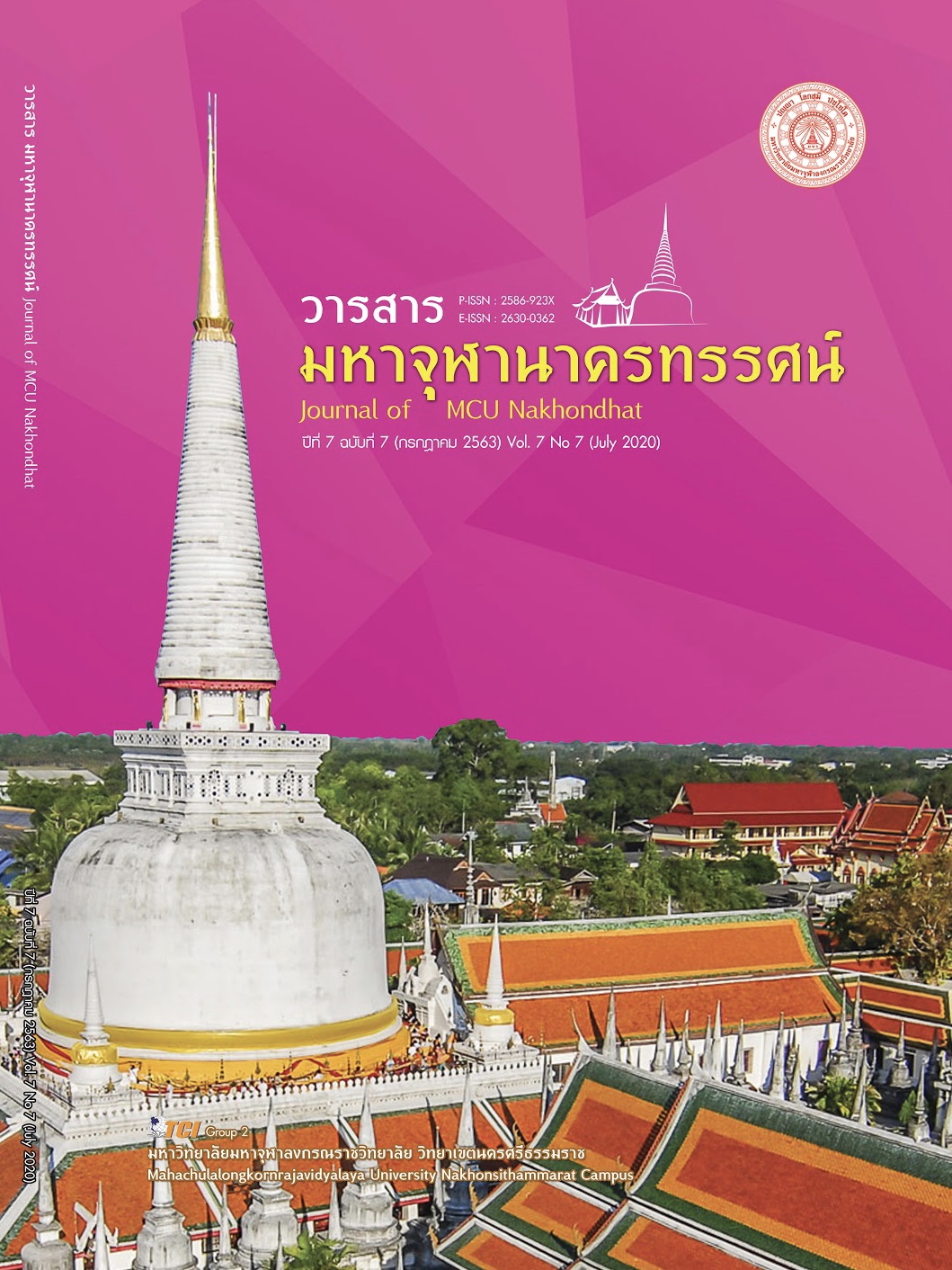BUDDHADHAMMA AND THE DEVELOPMENT OF VOLUNTEER SPIRIT FOR STUDENT IN THE 21ST CENTURY
Main Article Content
Abstract
This academic article The author will present Buddhism and the development of volunteer spirit in the 21st century from the study of Thai literature synthesis, research, and Thai educational policy that reflects Importance and guidelines for student volunteer development in the 21st century. Which is both the affected person and the hope of society during the time that Thailand entered the developed countries. The way of life of the Thai people in the 21st century has changed faster and more complicated than the past. Moving into the 4th industrial revolution or Industry 4.0. Amid capitalism and economic competition Resulting in people in society having material values Focusing on self – interest Taking advantage of Lack of serious and continuous moral and ethical development. Resulting in an imbalance in both the mind and the object. It is accepted that the creation of people starts with the development of the mind. All the dharma is the president, the heart is great cultivating and encouraging young people in the 21st century to have volunteer spirit and willingness to give all human beings willingly and willingly is the first priority. Which requires cooperation from the family institution educational institutions and network partners at all levels to bring young people with good hearts. When students graduate, they have persistent volunteer characteristics. There is a culture of helping others in society. Create strong and creative communities for the benefit of society to advance to the developed countries. B – LAS Model which consists of B – Buddhist, L – Learning, A – Acting, S – Sharing is the strategy that the author will Presented for further volunteer development for students in the 21st century.
Article Details
References
ดวงเดือน พันธมนาวิน และคณะ. (2549). ทฤษฏีต้นไม้จริยธรรม: การวิจัยประยุกต์. กรุงเทพมหานคร: โรงพิมพ์จุฬาลงกรณ์มหาวิทยาลัย.
ธรรมนันทิกา แจ้งสว่าง. (2547). ผลการใช้โปรแกรมพัฒนาจิตสาธารณะด้วยบทบาทสมมุติกับตัวแบบของนักเรียนชั้นประถมศึกษาปีที่ 3. ใน วิทยานิพนธ์วิทยาศาสตรมหาบัณฑิต สาขาวิชาการวิจัยพฤติกรรมศาสตร์ประยุกต์. มหาวิทยาลัยศรีนครินทร์วิโรฒประสานมิตร.
นันทวัฒน์ ชุนชี. (2546). การใช้ตัวแบบสัญลักษณ์ผ่านหนังสือเรียนเล่มเล็กเชิงวรรณกรรมเพื่อพัฒนาจิตสาธารณะในนักเรียนชั้นประถมศึกษาปีที่ 2. ใน วิทยานิพนธ์วิทยาศาสตรมหาบัณฑิต สาขาวิชาการวิจัยพฤติกรรมศาสตร์ประยุกต์. มหาวิทยาลัยศรีนครินทร์วิโรจประสานมิตร.
บุญทัน ภูบาล. (2549). การใช้วีดีทัศน์ละครหุ่น เชิดเป็นตัวแบบเพื่อพัฒนาจิตสาธารณะของนักเรียนชั้นประถมศึกษาปีที่ 2. ใน วิทยานิพนธ์การศึกษามหาบัณฑิต สาขาการวิจัยและสถิติทางการศึกษา. มหาวิทยาลัยศรีนครินทร์วิโรฒ.
พระไพศาล วิสาโล. (2559). เครือข่ายจิตอาสา คู่มือจิตอาสาโครงการจิตอาสาเพื่อในหลวง. กรุงเทพมหานคร: สหธรรมมิก.
สำนักเลขาธิการนายกรัฐมนตรี. (2560). วารสารไทยคู่ฟ้าออนไลน์ เล่มที่ 33 มกราคม – มีนาคม 2560. เรียกใช้เมื่อ 11 มีนาคม 2563 จาก www.thagov.go.th
สำนักงานคณะกรรมการข้าราชการพลเรือน. (2542). เอกสารชุดการส่งเสริมประสิทธิภาพและจริยธรรมในองค์กร. กรุงเทพมหานคร: สำนักงาน ก.พ.
สำนักวิชาการและมาตรฐานการศึกษา. (2553). แนวทางการจัดกิจกรรมพัฒนาผู้เรียนตามหลักสูตรแกนกลาง. กรุงเทพมหานคร: สำนักงานคณะกรรมการการศึกษาขั้นพื้นฐาน กระทรวงศึกษาธิการ.
สุคนธรส หุตะวัฒนะ. (2550). ผลของการใช้โปรแกรมพัฒนาจิตสาธารณะด้วยเทคนิค เสนอตัวแบบผ่านการ์ตูนร่วมกับการชี้แนะทางวาจาที่มีต่อจิตสาธารณะของนักเรียนชั้นประถมศึกษาปีที่ 3. ใน วิทยานิพนธ์วิทยาศาสตรมหาบัณฑิต สาขาวิชาการวิจัยพฤติกรรมศาสตร์ประยุกต์. มหาวิทยาลัยศรีนครินทร์วิโรจน์ประสานมิตร.
สุพักตร์ พิบูลย์. (2544). กลยุทธ์การวิจัยเพื่อพัฒนางาน วิจัยเพื่อพัฒนาองค์กร. นนทบุรี: จตุพรดีไซน์.
สุวิทย์ เมษินทรีย์. (2559). ประเทศไทย 4.0. เรียกใช้เมื่อ 12 มีนาคม 2563 จาก http://planning2.mju.ac.th/government/20111119104835_planning/Doc_25590823143652_358135.pdf
อัญชลี ยิ่งรักพันธุ์. (2560). ผลการใช้สถานการณ์จำลองสถานการณ์จำลองผสานกับเทคนิค การประเมินผลจากสภาพจริงเพื่อพัฒนาจิตสาธารณะของนักเรียน ชั้นประถมศึกษา ปีที่ 5. ใน วิทยานิพนธ์การศึกษามหาบัณฑิต สาขาการวัดผลการศึกษา. มหาวิทยาลัยศรีนครินทร์ทรวิโรจน์.


